|
|
In 1935, the monument was refashioned in accordance with Hitler's plans. The changes were linked to the fact that the remains of Marshal Hindenburg were to be placed inside (the originally planned function of the tower was changed), the level of the yard being lowered by 2,5 metres. The central wooden cross and the site devoted to the cross of the 20 unknown soldiers were removed. In addition to this, the inner yard was paved with stone paving slabs and staircases leading to the towers were built. While, thanks to this refashioning, it took on the character of an amphitheatre; additionally, this new adaptation facilitated annual political manifestations with the participation of thousands of people brought to the monument in special trains from all over Germany. Due to the enormous interest and German propaganda, a large tourist infrastructure was developed around the monument. The area of the village of Sudwa was incorporated within the borders of the city of Olsztyn and, thanks to this, the area accommodating the monument fell under the administration of the municipal authority (commune), culminating in new roads, pavements and parks being built. What is more, a "Cemetery of Heroes" was created, devoted to the soldiers who fell in 1919, with the architectural concept also embracing the construction of a sports stadium with large a number of youth hostels, an amphitheatre, and the inn of Tannenbergkrug (now the site accommodating Zajazd Mazurski), and a building with a lighted map. The course of the Battle of Tannenberg being illustrated by blinking, marked lamps. The functioning of this unusual device was even described by Melchior Wańkowicz in his book Na tropach Smętka, where the author emphasises that the inventor of this "multi-media" project spent five years working on it. Architectural plans of Tannenberg-Denkmal also embraced the development of the vast areas surrounding it. Between the monument and the nearby town of Olsztynek, for instance, a park of 7.5 hectares was created, with new paths and avenues being indicated and marked by the trees planted alongside them. 300 hundred metres from the Mausoleum, the monument of a lion was located, devoted to the memory of the soldiers of 147th Infantry Regiment, designed by the Italian sculptor Michelangelo Pietrobelli. Originally, the monument was placed on an 8-metre high pyramid-shaped plinth, its measurements being 210 cm in length, 210 cm in height, and 110 cm in width, and weighing 7 tons. The Prussian Lion of the monument was carved from a single block of granite with the sphere under its left paw symbolising the globe, over which the German Kingdom was supposed to spread its protection. The monument itself survived the subsequent breaking up and dismantling of the Mausoleum, with soldiers finally lifting the effigy from its plinth with a crane and transporting it away in the 1950s. The Lion being moved to the Training Centre of Border Guards in Kętrzyn, which is why it probably managed to survive. In 1993 the Kętrzyn Commander presented an effigy of the lion to the Town of Olsztynek. Now, it stands on a low, stone plinth in the square in front of the Olsztynek Town Hall. Here, it is also worth mentioning another monument located in the vicinity of the Mausoleum, that of a stylised horse pond, which is explained by the fact that it was devoted to the memory of those horses which died during the historic battle. Translated by Marzena Beata Guzowska
1
2
|
.jpg)
The entire architectural concept seen from an aerial perspective. The
original shape of the monument with the adjacent sports stadium and the
effigy of the lion devoted to the memory of the soldiers of the 147 Infantry
Regiment. .jpg)
A view of the monument to the courtyard with the altar and cross in the centre. A photograph from the 1930s. .jpg)
The courtyard of the monument, refashioned after Hitler's plans. Changes were made after Hindenburg's death in 1935. |
|||
| |||||
